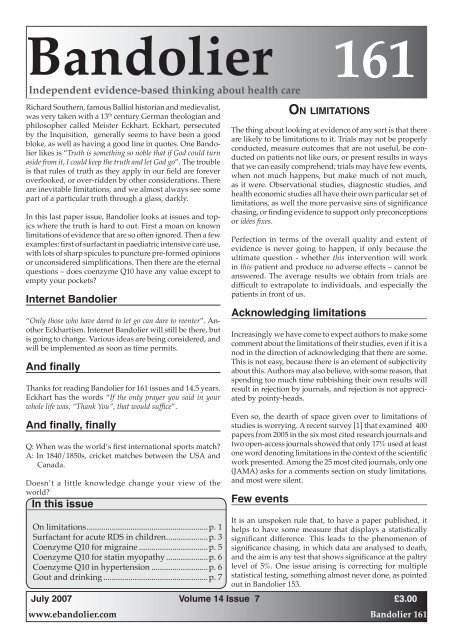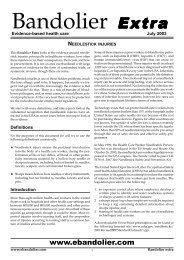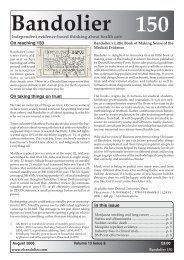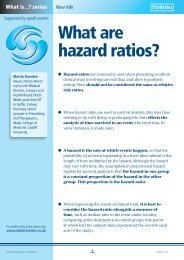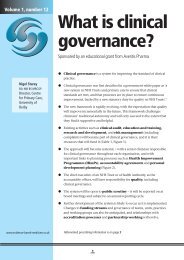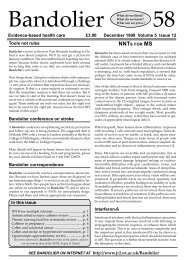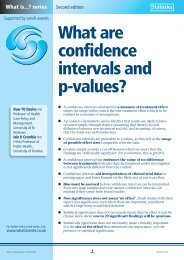Bandolier 161.indd
Bandolier 161.indd
Bandolier 161.indd
Create successful ePaper yourself
Turn your PDF publications into a flip-book with our unique Google optimized e-Paper software.
<strong>Bandolier</strong><br />
Independent evidence-based thinking about health care<br />
Richard Southern, famous Balliol historian and medievalist,<br />
was very taken with a 13 th century German theologian and<br />
philosopher called Meister Eckhart. Eckhart, persecuted<br />
by the Inquisition, generally seems to have been a good<br />
bloke, as well as having a good line in quotes. One <strong>Bandolier</strong><br />
likes is “Truth is something so noble that if God could turn<br />
aside from it, I could keep the truth and let God go”. The trouble<br />
is that rules of truth as they apply in our fi eld are forever<br />
overlooked, or over-ridden by other considerations. There<br />
are inevitable limitations, and we almost always see some<br />
part of a particular truth through a glass, darkly.<br />
In this last paper issue, <strong>Bandolier</strong> looks at issues and topics<br />
where the truth is hard to out. First a moan on known<br />
limitations of evidence that are so often ignored. Then a few<br />
examples: fi rst of surfactant in paediatric intensive care use,<br />
with lots of sharp spicules to puncture pre-formed opinions<br />
or unconsidered simplifi cations. Then there are the eternal<br />
questions – does coenzyme Q10 have any value except to<br />
empty your pockets?<br />
Internet <strong>Bandolier</strong><br />
“Only those who have dared to let go can dare to reenter”. Another<br />
Eckhartism. Internet <strong>Bandolier</strong> will still be there, but<br />
is going to change. Various ideas are being considered, and<br />
will be implemented as soon as time permits.<br />
And fi nally<br />
Thanks for reading <strong>Bandolier</strong> for 161 issues and 14.5 years.<br />
Eckhart has the words “If the only prayer you said in your<br />
whole life was, “Thank You”, that would suffi ce”.<br />
And fi nally, fi nally<br />
Q: When was the world’s fi rst international sports match?<br />
A: In 1840/1850s, cricket matches between the USA and<br />
Canada.<br />
Doesn’t a little knowledge change your view of the<br />
world?<br />
In this issue<br />
On limitations ..........................................................p. 1<br />
Surfactant for acute RDS in children ....................p. 3<br />
Coenzyme Q10 for migraine .................................p. 5<br />
Coenzyme Q10 for statin myopathy ....................p. 6<br />
Coenzyme Q10 in hypertension ...........................p. 6<br />
Gout and drinking ..................................................p. 7<br />
ON LIMITATIONS<br />
161<br />
The thing about looking at evidence of any sort is that there<br />
are likely to be limitations to it. Trials may not be properly<br />
conducted, measure outcomes that are not useful, be conducted<br />
on patients not like ours, or present results in ways<br />
that we can easily comprehend; trials may have few events,<br />
when not much happens, but make much of not much,<br />
as it were. Observational studies, diagnostic studies, and<br />
health economic studies all have their own particular set of<br />
limitations, as well the more pervasive sins of signifi cance<br />
chasing, or fi nding evidence to support only preconceptions<br />
or idées fi xes.<br />
Perfection in terms of the overall quality and extent of<br />
evidence is never going to happen, if only because the<br />
ultimate question - whether this intervention will work<br />
in this patient and produce no adverse effects – cannot be<br />
answered. The average results we obtain from trials are<br />
diffi cult to extrapolate to individuals, and especially the<br />
patients in front of us.<br />
Acknowledging limitations<br />
Increasingly we have come to expect authors to make some<br />
comment about the limitations of their studies, even if it is a<br />
nod in the direction of acknowledging that there are some.<br />
This is not easy, because there is an element of subjectivity<br />
about this. Authors may also believe, with some reason, that<br />
spending too much time rubbishing their own results will<br />
result in rejection by journals, and rejection is not appreciated<br />
by pointy-heads.<br />
Even so, the dearth of space given over to limitations of<br />
studies is worrying. A recent survey [1] that examined 400<br />
papers from 2005 in the six most cited research journals and<br />
two open-access journals showed that only 17% used at least<br />
one word denoting limitations in the context of the scientifi c<br />
work presented. Among the 25 most cited journals, only one<br />
(JAMA) asks for a comments section on study limitations,<br />
and most were silent.<br />
Few events<br />
It is an unspoken rule that, to have a paper published, it<br />
helps to have some measure that displays a statistically<br />
signifi cant difference. This leads to the phenomenon of<br />
signifi cance chasing, in which data are analysed to death,<br />
and the aim is any test that shows signifi cance at the paltry<br />
level of 5%. One issue arising is correcting for multiple<br />
statistical testing, something almost never done, as pointed<br />
out in <strong>Bandolier</strong> 153.<br />
July 2007 Volume 14 Issue 7 £3.00<br />
www.ebandolier.com 1<br />
<strong>Bandolier</strong> 161
The more important question, not asked anything like often<br />
enough, is whether any statistical testing is appropriate. Put<br />
another way, when can we be sure that we have enough<br />
information to be sure of the result, using the mathematical<br />
perspective of sure, meaning the probability to a certain<br />
degree that we are not being mucked about by the random<br />
play of chance? This is not a trivial question, given that<br />
many results, especially concerning rare but serious harm,<br />
are driven by very few events.<br />
A few older papers keep being forgotten. When looking<br />
at the strengths and weaknesses of smaller meta-analyses<br />
versus larger randomised trials, a group from McMaster<br />
[2] suggested that with fewer than 200 outcome events<br />
research (meta-analyses in this case) may only be useful<br />
for summarising information and generating hypotheses<br />
for future research.<br />
A different approach using simulations of clinical trials and<br />
meta-analyses [3] arrived at pretty much the same conclusion,<br />
that with fewer than 200 events the magnitude and<br />
direction of an effect becomes increasingly uncertain.<br />
Just how many events is needed to be reasonably sure of a<br />
result when event rates are low (as in the case for rare but<br />
serious adverse events) was explored some while ago [4].<br />
<strong>Bandolier</strong>’s best try at explaining lots of maths and tables<br />
appears in Table 1. This looks at a number of examples, varying<br />
event rates in experimental and control groups, using<br />
probability limits of 5% and a more stringent one of 1%, and<br />
with the power of 80% and 90% to detect an effect.<br />
Event rates<br />
(probabilities)<br />
Mean<br />
event<br />
rate<br />
(%)<br />
and larger numbers of patients in trials. Once event rates fall<br />
to about 1% or so, and differences between experimental<br />
and control to less than 1%, the number of events needed<br />
approaches 100 and number of patients rises to tens of<br />
thousands.<br />
Subgroup analyses<br />
One of the best examples of the dangers of subgroup analysis,<br />
due to unknown confounding, comes from a review article<br />
[5]. It examined the 30-day outcome of death or myocardial<br />
infarction from a meta-analysis of platelet glycoprotein<br />
inhibitors. Analysis indicated different results for women<br />
and men (Figure 1), with benefits in men but not women.<br />
Statistically this was highly significant (p75 >500000 >75 >500000 >75 >500000 >75 >500000<br />
<strong>Bandolier</strong> 161 2<br />
www.ebandolier.com<br />
Men<br />
Power of 80% Power of 90%<br />
p1000 >75 >1000<br />
0.01 0.005 0.75 67 8933 >75 >10000 >75 >10000 >75 >10000<br />
0.001 0.0005 0.075 67 89333 >75 >100000 >75 >100000 >75 >100000<br />
0.04 0.01 2.5 23 920 34 1360 29 1160 42 1680<br />
0.004 0.001 0.25 23 9200 34 13600 29 11600 42 16800<br />
0.0004 0.0001 0.025 23 92000 34 136000 29 116000 42 168000<br />
0.03 0.01 2.0 33 1650 48 2400 42 2100 59 2950<br />
0.003 0.001 0.2 33 16500 48 24000 42 21000 59 29500<br />
0.0003 0.0001 0.02 33 165000 48 240000 42 210000 59 295000<br />
0.02 0.01 1.5 >75 >5000 >75 >5000 >75 >5000 >75 >5000<br />
0.002 0.001 0.15 >75 >50000 >75 >50000 >75 >50000 >75 >50000
Table 2: What different levels of relative risk<br />
actually mean<br />
Relative risk What this means<br />
2.0 Higher risk of events with experimental<br />
intervention, and most events occur<br />
because of the experimental intervention<br />
Trivial differences<br />
It is worth remembering what relative risks tell us in terms of<br />
raw data (Table 2). Suppose we have a population in which<br />
100 events occur with our control intervention, whatever<br />
that is. If we have 150 events with an experimental, the relative<br />
risk is now 1.5. It may be statistically significant, but<br />
most events were those occurring anyway. If there were 250<br />
events, the relative risk would be 2.5, and now most events<br />
would occur because of the experimental intervention.<br />
Large relative risks may be important, even with more<br />
limited data. Small relative risks, probably below 2.0, and<br />
certainly below about 1.5 should be treated with caution, especially<br />
where the number of events is small, and even more<br />
especially outside the context of the randomised trial.<br />
The importance of a relative risk of 2.0 has been accepted in<br />
US courts [6]. “A relative risk of 2.0 would permit an inference<br />
than an individual plaintiff’s disease was more likely than not<br />
caused by the implicated agent. A substantial number of courts in<br />
a variety of toxic substance cases have accepted this reasoning.”<br />
Confounding by indication etc<br />
Bias arises in observational studies when patients with the<br />
worst prognosis are allocated preferentially to a particular<br />
treatment. These patients are likely to be systematically different<br />
from those not treated, or treated with something else<br />
(paracetamol, rather than NSAID in asthma, for instance).<br />
Confounding, by factors known or unknown, is potentially a<br />
big problem, because we do not know what we do not know,<br />
and the unknown could have big effects – like troponin<br />
above. When relative risks are small, say below about 1.3,<br />
potential bias created because of unknown confounding, or<br />
confounding by indication improperly adjusted, becomes so<br />
great that it makes any conclusion at best unreliable.<br />
Comment - the uncertainty principle<br />
These are just a few of the limitations <strong>Bandolier</strong> sees in<br />
papers and talks. There are more, obviously. Worst of all<br />
is an outcome failing to reach statistical significance at a<br />
trivial level like 5% despite multiple statistical compari-<br />
sons then being trumpeted as a “result”, and extrapolated<br />
to whole populations. If it ain’t statistically significant, it<br />
don’t signify.<br />
The trouble is that we live in an imperfect world, where we<br />
never have the truth, the whole truth, and nothing but the<br />
truth on which to work and build judgements. We have to<br />
make do with what we have, and try our best to exclude<br />
the rubbish. Some try a philosophical approach to calculate<br />
thresholds above which we can begin to believe [7], but that<br />
seems a bit too glib.<br />
References:<br />
1 JPA Ioannidis. Limitations are not properly acknowledged<br />
in the scientific literature. Journal of Clinical<br />
Epidemiology 2007 60: 324-329.<br />
2 MD Flather et al. Strengths and limitations of metaanalysis:<br />
larger studies may be more reliable. Controlled<br />
Clinical Trials 1997 18: 568-579.<br />
3 RA Moore et al. Size is everything - large amounts of<br />
information are needed to overcome random effects<br />
in estimating direction and magnitude of treatment<br />
effects. Pain 1998 78: 209-16.<br />
4 JJ Shuster. Fixing the number of events in large<br />
comparative trials with low event rates: a binomial<br />
approach. Controlled Clinical Trials 1993 14: 198-208.<br />
5 SG Thompson, JPT Higgins. Can meta-analysis help<br />
target interventions at individuals most likely to benefit?<br />
Lancet 2005 365: 341-346.<br />
6 Annual Reference Manual on Scientific Evidence 2 nd<br />
Edition, 2005-2006, p539 (ISBN 0820547549).<br />
7 B Djulbegovic, I Hozo. When should potentially false<br />
results be considered acceptable? PLoS Medicine 2007<br />
4:2:e26.<br />
SURFACTANT FOR ACUTE<br />
RESPIRATORY FAILURE IN CHILDREN<br />
The use of exogenous pulmonary surfactant in the respiratory<br />
distress syndrome of the newborn is known to reduce<br />
mortality by almost half, as well as having other benefits.<br />
The use of surfactant in that setting is well understood, and<br />
forms part of several guidelines.<br />
The benefits of using pulmonary surfactant in other settings<br />
is less clear, and the specific example of its use in acute respiratory<br />
failure in children [1] makes for interesting reading,<br />
with some lessons for decision-makers.<br />
Systematic review<br />
The review searched several databases (to about 2005), together<br />
with bibliographies, trial registries, and conference<br />
proceedings. Randomised trials were included comparing<br />
pulmonary surfactant plus standard care with standard care<br />
alone in intubated, mechanically ventilated patients with<br />
acute respiratory failure. Studies in neonates with respiratory<br />
distress syndrome were not part of the review. At least<br />
one dose of surfactant had to be used.<br />
www.ebandolier.com 3<br />
<strong>Bandolier</strong> 161
Table 1: Main outcomes of clinical trials of<br />
surfactant in paediatric patients with respiratory<br />
failure<br />
Outcomes sought were all case mortality, number of ventilator-free<br />
days to day 28, duration of mechanical ventilation,<br />
duration of stay on paediatric intensive care unit, and others,<br />
like adverse events.<br />
Results<br />
Six studies (311 patients) were found, two with blind<br />
intensive care teams. Three trials enrolled 79 infants aged<br />
mostly below one year with respiratory syncytial virus<br />
induced respiratory failure or severe bronchiolitis; there<br />
were no deaths in this group which we will call group A.<br />
Three other trials enrolled 226 children of average age four<br />
to seven years with acute respiratory distress syndrome or<br />
acute lung injury, including pneumonia, sepsis, and near<br />
drowning; in this group the mortality rate averaged 28%<br />
(group B).<br />
The main results are shown in Table 1. For group A, there<br />
were more ventilator free days, fewer days of mechanical<br />
ventilation, and fewer days on the paediatric intensive care<br />
unit on average. For group B, older children, there were<br />
more ventilator free days and fewer days of mechanical<br />
ventilation. In addition, there was a 13% reduction in mortality<br />
(NNT to prevent one death 8 (95% confidence interval<br />
4 to 220)). There were no adverse events directly related to<br />
the use of surfactant.<br />
Comment<br />
Group B<br />
COENZYME Q10 AND MIGRAINE<br />
Coenzyme Q10 has been like an old but embarrassing friend<br />
to <strong>Bandolier</strong>. Over the years, many readers have asked for<br />
an appreciation of the evidence relating to all the wonderful<br />
health-giving properties it supposedly has. Ever obedient,<br />
<strong>Bandolier</strong> scurries off to look for this evidence, but finds<br />
none – hence the embarrassment.<br />
It is ironic, then, that just now there is a smidgin of evidence<br />
that Q10 may be useful in preventing frequent headaches<br />
and/or migraine. The dictionary definition of smidgin is a<br />
tiny or scarcely detectable amount, so don’t hold your breath<br />
for anything exceptional.<br />
Search<br />
Searching was fairly simple, looking for articles with coenzyme<br />
Q10, ubiquinone, and/or headache or migraine. Any<br />
study was accepted, cohort or randomised trial, as long<br />
as it reported some indicator of frequency of migraine or<br />
headaches, principally as the number of patients with at<br />
least a 50% reduction in the number of migraine or headache<br />
attacks (number per month) or days affected per month.<br />
Results<br />
Three studies were found, two cohorts, and one randomised<br />
trial, all published since 2002.<br />
Cohort studies<br />
The first cohort [1] included 32 patients with International<br />
Headache Society-defined migraine for at least one year,<br />
and usually with two to eight migraine attacks each month.<br />
All were seen by a neurologist before study entry, and a full<br />
history and examination performed. Treatment consisted of<br />
a baseline month followed by three months of coenzyme<br />
Q10 at 150 mg daily, given once in the morning.<br />
Among the 31 completers, 19 (61%) had at least 50% reduction<br />
in headache days per month, and 29 (93%) had at least<br />
a 25% reduction (average of last two months on treatment).<br />
The mean number of days per month with headache fell<br />
from 7.3 to 3.0. The mean number of attacks fell from 4.9<br />
per month at baseline to 2.8 during the last two months of<br />
treatment. There was no difference in severity of headache<br />
or associated symptoms, and no adverse events reported<br />
with coenzyme Q10.<br />
The second cohort [2] reported on a consecutive series of<br />
1,550 paediatric and adolescent patients with migraine (ICD<br />
classification) in whom a series of coenzyme Q10 measurements<br />
were made. The reference range used for serum coenzyme<br />
Q10 was 0.5 to 1.5 mg/L; 1143 had levels below 0.7<br />
mg/L and 510 had levels below 0.5 mg/L. Coenzyme Q10<br />
supplementation was recommended (at 1 to 3 mg/kg/day)<br />
for those below 0.7 mg/L.<br />
Figure 1: At least 50% reduction in headache<br />
frequency (dark) or days (light)<br />
Percent with at least 50% reduction<br />
80<br />
60<br />
40<br />
20<br />
0<br />
Rozen Hershey Sándor<br />
Reference<br />
initially below 0.7 mg/L. In those taking supplements,<br />
there was at least a 50% reduction in headache frequency<br />
in 46%. The average number of headache days per month<br />
fell from 19 to 13.<br />
Randomised trial<br />
This trial [3] randomised 43 patients with IHS-defined<br />
migraine occurring two to eight times a month to 300 mg<br />
coenzyme Q10 daily or placebo. The trial was of good quality<br />
(properly randomised and double blind), but six patients<br />
dropped out after randomisation. A baseline month was<br />
followed by three months of treatment.<br />
The proportion of patients with at least a 50% reduction in<br />
attack frequency was 3/21 (14%) with placebo and 10/21<br />
(48%) with coenzyme Q10 for the last month of treatment<br />
compared with baseline. There was no difference in migraine<br />
severity, but there were fewer migraine days and<br />
days with nausea or vomiting.<br />
Comment<br />
As Figure 1 shows, there was a consistent improvement for<br />
major reduction in headache frequency or days of headache<br />
per month in both cohort studies and the randomised trial.<br />
Half the people involved had a major benefit in headache<br />
reduction.<br />
But the evidence itself is not extensive. The total number<br />
of patients on coenzyme Q10 was about 300, and with only<br />
a single small randomised trial of good quality there is not<br />
sufficient good evidence to be sure of benefit (or adverse<br />
events, come to that).<br />
Let’s face it, if a huge trial told us there was no effect, then<br />
we might not be surprised. But no such trial is likely. While<br />
coenzyme Q10 is being tested in a number of indications, no<br />
further trials in migraine prevention appear to have been<br />
registered, so this is all we have to go on right now.<br />
References:<br />
1 TD Rozen et al. Open label trial of coenzyme Q10 as a<br />
migraine preventive. Cephalalgia 2002 22: 137-141.<br />
2 AD Hershey et al. Coenzyme Q10 deficiency and<br />
response to supplementation in pediatric and adoles-<br />
In 252 young patients who took supplements and who had<br />
follow up data, mean serum coenzyme Q10 levels rose from<br />
0.5 to 1.2 mg/L, with a large increase in those with levels<br />
3<br />
cent migraine. Headache 2007 47: 73-80.<br />
PS Sándor et al. Efficacy of coenzyme Q10 in migraine<br />
prophylaxis: a randomized controlled trial. Neurology<br />
2005 64: 713-715.<br />
www.ebandolier.com 5<br />
<strong>Bandolier</strong> 161
COENZYME Q10 AND<br />
STATIN MYOPATHY<br />
For some time there has been a view that the muscle pains<br />
associated with statins may be reversed by taking coenzyme<br />
Q10. The argument is that statins inhibit the biosynthesis of<br />
both cholesterol and ubiquinone (fancy name for coenzyme<br />
Q10), with resultant lowering of cholesterol and ubiquinone<br />
in blood, ubiquinone in muscle, and, as ubiquinone is involved<br />
in electron transport and ATP formation, fatigue<br />
and muscle pain.<br />
Whether taking coenzyme Q10 helps overcome that muscle<br />
pain is another matter, but there are a few straws in the<br />
wind.<br />
Systematic review<br />
A systematic review [1] sought all the evidence linking<br />
coenzyme Q10 with statin-associated myopathy, searching<br />
for English language articles in a PubMed search to August<br />
2006, together with examination of reference lists. While it<br />
examines animal and human studies, only the human studies<br />
are mentioned here.<br />
Results<br />
Circulating coenzyme Q10<br />
The review found nine randomised trials and nine observational<br />
studies looking at effects of statins on circulating<br />
levels of coenzyme Q10. Most of these were of a few weeks<br />
duration, and involved fewer than 50 patients. The two<br />
studies with at least 100 patients, both randomised, observed<br />
reductions in circulating coenzyme Q10 of 22% and<br />
27-38% in 120 and 1,049 people respectively at 12 weeks<br />
and one year.<br />
Most of the reduction in circulating coenzyme Q10 is related<br />
to lower levels of LDL-cholesterol, and some studies suggest<br />
that absolute changes are less relevant than the coenzyme<br />
Q10/cholesterol ratio [2].<br />
Muscle coenzyme Q10<br />
Five studies looked at muscle levels, one finding and increase,<br />
one a decrease, and three no difference.<br />
Mitochondrial function<br />
There is no consistent message of impairment to muscle<br />
metabolism with statins, or any suggestion that coenzyme<br />
Q10 is related to any changes.<br />
Clinical studies<br />
There is a dearth of clinical studies of coenzyme Q10 supplementation<br />
in statin-associated myopathy. None was<br />
published in full at the time of the systematic review. Two<br />
subsequent reports of randomised trials are too small to be<br />
conclusive.<br />
One [3] compared daily coenzyme Q10 100 mg with vitamin<br />
E at 400 IU daily in 32 patients with myopathic symptoms<br />
on statins. After 30 days overall pain severity decreased, and<br />
pain interfered less with activities of daily living, but most<br />
patients taking coenzyme Q10 still had some pain.<br />
A second report [4] records a randomised trial that managed<br />
to recruit only three patients with statin-associated myopathy<br />
in 1.5 years, because patients stopped the statin, or<br />
were already taking coenzyme Q10. All three had low initial<br />
circulating coenzyme Q10 levels, and two had significant<br />
improvements in mobility and energy levels together with<br />
increased circulating levels on blind or open challenge.<br />
Comment<br />
There really is not much evidence that coenzyme Q10 is effective<br />
in combating fatigue and muscle pain with statins.<br />
For some patients it does make a difference, though. A<br />
number of randomised trials are ongoing, so perhaps this is<br />
a space worth watching. At least one more moderate sized<br />
trial is ongoing, completing by the end of 2007.<br />
References:<br />
1 L Marcoff, PD Thompson. The role of coenzyme Q10<br />
in statin-associated myopathy. Journal of the American<br />
College of Cardiology 2007 49: 2231-2237.<br />
2 AD Hershey et al. Coenzyme Q10 deficiency and<br />
response to supplementation in pediatric and adolescent<br />
migraine. Headache 2007 47: 73-80.<br />
3 G Caso et al. Effect of coenzyme Q10 on myopathic<br />
symptoms in patients treated with statins. American<br />
Journal of Cardiology 2007 99: 1409-1412.<br />
4 MM Reidenberg. Statins, lack of energy and ubiquinone.<br />
British Journal of Clinical Pharmacology 2005<br />
59: 606-607.<br />
COENZYME Q10 IN HYPERTENSION<br />
Coenzyme Q10 is one of those universal food supplements<br />
that is recommended for just about every ailment, without<br />
much, if anything, in the way of evidence. For hypertension,<br />
though, there is a small amount of evidence, and a<br />
systematic review [1] pulls the results together.<br />
Systematic review<br />
The review used a number of databases to find studies<br />
published up to 2005 that described therapy of hypertension<br />
with coenzyme Q10. The main outcome was the change<br />
in systolic and diastolic blood pressure between start and<br />
end of the trial.<br />
Results<br />
Twelve studies were found. Three randomised trials (130<br />
patients) compared 100 or 120 mg coenzyme Q10 daily with<br />
placebo for eight or 12 weeks. Mean systolic blood pressure<br />
was about 166 mmHg and diastolic about 92 mmHg, either<br />
with or without other antihypertensive treatments.<br />
<strong>Bandolier</strong> 161 6<br />
www.ebandolier.com
Figure 1: Reduction in systolic blood pressure<br />
with coenzyme Q10 and placebo in<br />
randomised trials<br />
SBP reduction with coenzyme Q10<br />
-20 -16 -12 -8 -4 0<br />
0<br />
Coenzyme Q10 resulted in mean decreases in systolic blood<br />
pressure of about 15 mmHg more than placebo (Figure 1),<br />
and of about 3-7 mmHg more than placebo in diastolic<br />
blood pressure.<br />
Eight open observational studies reported on four to 109 patients<br />
(214 total) taking 30 mg to 225 mg coenzyme Q10 daily<br />
for 1 to 56 weeks. The weighted mean decrease in systolic<br />
blood pressure was 13 mmHg (range 10-21 mmHg), and in<br />
diastolic blood pressure of 9 mmHg (range 6-16 mmHg).<br />
Comment<br />
The consistency between these studies gives a certain weight<br />
to these results, despite the small numbers. Moreover, another<br />
randomised trial in 74 patients with type 2 diabetes [2]<br />
compared 200 mg coenzyme Q10 daily with placebo over 12<br />
weeks. It also achieved significant reductions in both systolic<br />
blood pressure by 6 mmHg more than placebo, and in<br />
diastolic blood pressure by 3 mmHg more than placebo.<br />
Interestingly, HbA1c levels fell by about 0.4% more with<br />
coenzyme Q10 than with placebo, from initial moderate<br />
levels of about 7%.<br />
Not a huge amount of information to go on, but better than<br />
a poke in the eye with a sharp stick. Right now there seem<br />
to be no new trials in this area, so that’s all there is to go on<br />
to make any decisions on this topic.<br />
References:<br />
100<br />
50<br />
-20<br />
SBP reduction with placebo<br />
1 FL Rosenfeld et al. Coenzyme Q10 in the treatment<br />
of hypertension: a meta-analysis of the clinical trials.<br />
Journal of Human Hypertension 2007 21: 297-306.<br />
2 JM Hodgson et al. Coenzyme Q10 improves blood<br />
pressure and glycaemic control: a controlled trial in<br />
subjects with type 2 diabetes. European Journal of<br />
Clinical Nutrition 2002 56: 1137-1142.<br />
0<br />
-4<br />
-8<br />
-12<br />
-16<br />
GOUT AND DRINKING<br />
People with gout, and their carers, tend to the obsessive<br />
when it comes to food, and especially drinking; alcohol and<br />
coffee are often banned completely. All of which makes for<br />
a bland existence, which is why a frequently asked question<br />
is what gout sufferers can drink without exacerbating their<br />
condition. A large US survey has reported on coffee, tea,<br />
and various forms of alcohol [1,2]. The results will warm<br />
the cockles of some hearts.<br />
Studies<br />
A representative sample of the US population was selected<br />
and studied between 1988 and 1994. Subjects were interviewed<br />
at home, and attended an examination, with blood<br />
and urine sample collection. During the interviews, a food<br />
frequency questionnaire was used which ascertained the<br />
frequency of consumption of coffee, tea, and alcoholic beverages,<br />
as well as soft drinks that might contain caffeine.<br />
Serum uric acid was measured also.<br />
Results<br />
The survey used data from over 14,000 people aged over<br />
20 years of age. Those with gout, or taking allopurinol or<br />
uricosuric agents were excluded.<br />
Coffee, tea, and caffeine<br />
Using a quintile of consumption approach, uric acid levels<br />
were identical across quintiles of intake of total caffeine<br />
and tea. For coffee (including decaffeinated), drinking more<br />
than four cups of coffee a day significantly lowered serum<br />
uric acid levels, by about 8% at maximum (Figure 1). The<br />
reduction of uric acid by coffee remained after adjusting for<br />
a whole range of variables and dietary factors.<br />
Alcohol<br />
Using the quintile of consumption approach drinking wine<br />
did not affect serum uric acid levels at any level of consumption<br />
up to one serving per day or more. The consumption<br />
Figure 1: Reduction in mean serum uric acid<br />
levels according to quintiles of daily intake of<br />
coffee<br />
0
Figure 2: Effect of different daily consumption (quintiles) of different alcoholic beverages on<br />
mean serum uric acid levels<br />
Difference in serum uric acid from no consumption (µmol/L)<br />
-10<br />
0 0.01-0.09 0.1-0.49 0.5-0.99 ≥1.0<br />
Frequency (servings per day)<br />
of spirits, and especially beer, did increase serum uric acid<br />
levels (Figure 2), even after adjusting for a whole range of<br />
factors. Beer and spirits drunk daily increased serum uric<br />
acid by about 10%; wine did not. The results were similar in<br />
men and women, and at lower and higher levels of BMI.<br />
Figure 3: Relative risk of incident gout in<br />
12-year follow up of 46,000 men, according to<br />
quintiles of daily coffee consumption<br />
Relative risk of incident gout<br />
Comment<br />
1<br />
This constitutes useful additional knowledge about what<br />
0.8<br />
gout suffers might do to avoid increasing their serum uric<br />
acid, and perhaps precipitating an attack, or making the<br />
pain worse. Drinking beer and spirits are out, but tea and<br />
0.6<br />
wine have no effect, while coffee actually seems to reduce<br />
uric acid levels. We have had some straws in the wind about<br />
coffee before, but this adds weight.<br />
0.4<br />
0.2<br />
0


